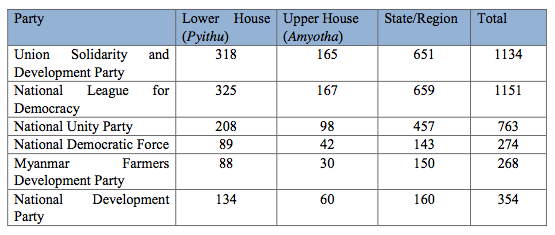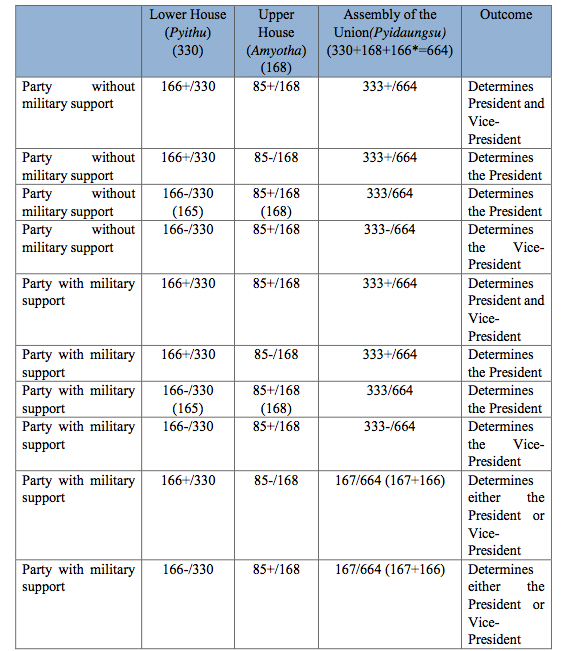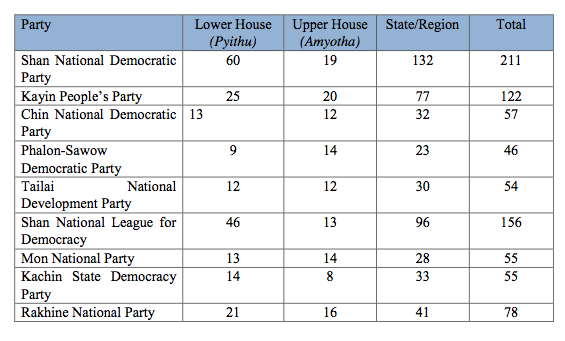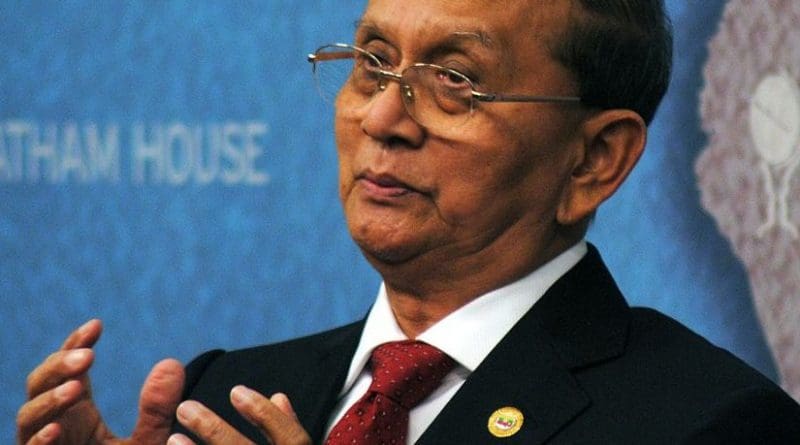Presidential Hopefuls In Myanmar’s 2015 Elections – Analysis
By ISEAS - Yusof Ishak Institute
By Maung Aung Myoe*
Myanmar’s General Elections being held on 8 November 2015 will determine the Assembly of the Union (Pyidaungsu Hluttaw) which comprises of the Lower House of Parliament (People Assembly, Pyithu Hluttaw) and the Upper House of Parliament (National Assembly, Amyotha Hluttaw) as well as the regional assemblies of the fourteen states and regions. A total of 1,171 seats being contested—330 seats in the Lower House, 168 in Upper House and 673 in regional assemblies. Of the 6,189 candidates, 1,772 are contesting for the Lower House, 915 for the Upper House and 3,504 for the regional assemblies. As many as 5,866 are representing 92 political parties while 323 are independents.
Where the two main contending parties are concerned, the Union Solidarity and Development Party (USDP) is fielding 318 candidates for the Lower House and 165 candidates for the Upper House against the 325 and 167 respectively being fielded by the National League for Democracy (NLD). Other non-ethnic based political parties with a significant number of candidates are the National Unity Party (NUP) – successor to the former Burma Socialist Programme Party (BSPP), the National Democratic Force (NDF), the Myanmar Farmers Development Party (MFDP) and the National Development Party (NDP). In accordance with the constitution, the Tatmadaw (Myanmar Defence Service) has 25 per cent of seats in both the Lower and Upper Houses with 110 and 56 seats (total of 166) respectively reserved for them.

PRESIDENTIAL SELECTION
According to the constitution, the Electoral College – or the Pyidaungsu Hluttaw – comprises (1) elected representatives of the Lower House, (2) elected representatives of the Upper House and (3) military representatives nominated by the Commander-in-Chief to serve in both Houses. Each of these would then nominate a candidate for Vice-President. The candidate with the most number of votes of the three will become President. In order for a political party or a coalition of parties to win the elections and form the government, it should ideally secure the presidency and win a minimum of 166 seats of 330 in the Lower House, 85 seats of 168 in the Upper House and a minimum of 333 seats, or more than 50 per cent, of a total of 664 in the Pyidaungsu Hluttaw (both the Upper and Lower Houses combined). There are several possible scenarios, as shown in the table below.

Collaboration between the military and a political party or coalition of political parties appears to be crucial for winning the presidency. If a political party or a coalition of parties manages to secure the support of the military, it has more options for forming the government as its vice- presidential candidate could potentially win enough votes to become President. Likewise, with the support of 167 representatives in Pyidaungsu Hluttaw from a friendly political party or parties, a vice-presidential candidate nominated by the Tatmadaw could become President. Under these circumstances, there are four possible presidential hopefuls.
A SECOND TERM FOR THEIN SEIN
In his interview with the Nikkei Weekly on 29 July 2015, Thein Sein has re-stated his intention and willingness to continue as president by saying:
“…with my age and with my health, I want to retire… I want to pass my duties to middle aged or young age of our country. But frankly speaking, in our country, there are very few young or middle aged people, who will be [able to steer] the country into the right direction.”
On the possibility of a second term, his standard statement seemed to be that it depended on “the country’s situation, the prevailing circumstances and wishes of the people”. What is more intriguing is how Thein Sein explained how he could become president for a second term without running:
“…as you know our electoral system on Presidency procedure is that you don’t need to run [for] in the elections because it is based on the parliamentarians [who] will choose the president. So [running in] the election is not necessary. But it will [be] chosen by parliamentarians through [the] Electoral College.”
According to article 60(C) of the 2008 constitution, each of the three groups that form the Electoral College “shall elect a Vice-President from among the Hluttaw representatives or from amongst persons who are not Hluttaw representatives”. Since the constitution does not require a President or Vice-President to be a representative in either houses of the Pyidaungsu Hluttaw, Thein Sein could become President for a second term without going through an electoral process.
There are two scenarios in which Thein Sein would become President for a second term. First, if the USDP and its coalition, if it should have any, manage to win 166+ seats in the Lower House and/or 85+ seats in the Upper House, with a minimum of 167 seats in the Pyidaungsu Hluttaw, Thein Sein could be nominated as a vice-presidential candidate. With the support of the Tatmadaw’s 166 seats, he could become President for a second term. Second, if the USDP does not manage to win either 166 seats in the Lower House and/or 85 seats in the Upper House, but still secures 167 seats in Pyidaungsu Hluttaw, then the only chance for Thein Sein to become President is through nomination by the Tatmadaw. In order for Thein Sein to be nominated as a vice-presidential candidate, he needs to secure a firm leadership position within the USDP and be supported from the Tatmadaw. The power struggle between Thein Sein and the USDP’s then ‘Acting Chairman’ Thura U Shwe Mann is hardly a secret, with both having not insignificant followers. In a desperate attempt to reinstate Thein Sein as the undisputed chairman of the USDP and to send a clear message to the Tatmadaw that the USDP leadership would not seek to undermine its constitutionally guaranteed role, the USDP attempted to oust Shwe Mann from the party leadership.
However, if the NLD and its allies should win 333+ seats in the Pyidaungsu Hluttaw and hold a majority of seats in both houses, what Thein Sein would then do remains to be seen. Even if the Tatmadaw nominates him as a vice-presidential candidate then,, unless some kind of understanding has been reached with the NLD, or more precisely with Aung San Suu Kyi, he will not be able to become President again.
THE RETURN OF THURA U SHWE MANN
Another presidential hopeful is Thura U Shwe Mann, present Speaker of the Lower House. Shwe Mann makes no secret of his ambition to become President and has started to mobilize support within the USDP. However, in a late night coup within the party’s central executive committee on 13 August 2015, Shwe Mann was ousted from the USDP leadership, but was allowed to retain his status in the Hluttaw. Shwe Mann is running for the Lower House as a USDP candidate for Phyu constituency. It is difficult to tell the strength of Shwe Mann’s support base within the USDP and the Tatmadaw, but it is interesting to note that the NLD has chosen to field a relatively weak candidate in that constituency and that Aung San Suu Kyi has avoided it on her campaign trail, hinting at undeclared support for Shwe Mann. Aung San Suu Kyi appears to be treating Shwe Mann as an ally and has expressed her disappointment on the removal of Shwe Mann from the USDP leadership.
One cannot rule out that the NLD under Aung San Suu Kyi’s leadership may reach an understanding with Shwe Mann and nominate him as a vice-presidential candidate should they win. It is also noteworthy that Aung San Suu Kyi told supporters to vote for the party, not for the candidate. This could mean that she controls the candidates and party policy and it is her decision that really matters.
The tension between Shwe Mann and the Tatmadaw makes it questionable whether they will support his presidential bid. The Tatmadaw leadership considers Shwe Mann a confrontational figure who has crossed the line a number of times. His support for the constitutional amendment of article 60(C) to make the vice-presidential candidate an elected representative; article 436(A) and (B) to remove the military’s veto over constitutional amendments by setting a lower threshold for approval; and for article 418(B) to constrain the power of the Commander-in-Chief in case of a declaration of a state of emergency in the country, had upset the Tatmadaw leadership. These proposed amendments were submitted by the USDP under the leadership of Shwe Mann and received significant support. All three proposals received over 66 per cent of the votes from the 583 representatives present that day at the Pyidaungsu Hluttaw. However the motions were not passed since for that to happen would have required more than 75 per cent of the vote. Nevertheless, this showed that there were a significant number of USDP backbenchers who supported Shwe Mann’s reform agenda. How many of Shwe Mann’s supporters would be voted back into the Hluttaw after the elections is something to watch.
AUNG SAN SUU KYI AND THE PRESIDENCY
Aung San Suu Kyi has openly talked about her ambition to become President. However, Article 59(F) of the constitution prevents anyone who owes allegiance to a foreign power, or is a citizen of a foreign country, or entitled to enjoy the rights and privileges of a citizen of a foreign country as well as anyone whose immediate family members have the above privileges, from becoming a vice-presidential candidate. This applies to Aung San Suu Kyi since her sons are British nationals. She now appears to concede that she cannot be President, and in one of her latest speeches1, she said that she could in that case lead the government from behind the scenes. A constitutional amendment to get around this article at this point of time is legally and logistically impossible.
Neither the NLD nor Aung San Suu Kyi has publicly identified the party’s vice-presidential candidate(s), and although Aung San Suu Kyi has once said that the candidate(s) should be from the NLD, she can change her mind. Such was the case, when she reversed her own decision not to run in the elections (in protest against constitutional amendments not be made. She can obviously be a kingmaker, and if the NLD wins the majority in both houses of Parliament and holds more than 333 seats in Pyidaungsu Hluttaw, it has the right to nominate two vice-presidential candidates of which one can potentially become the President.
The NLD and Aung San Suu Kyi enjoy widespread public support and sympathy among Myanmar people. The election results in the 1990 General Elections and 2012 by-elections testify to that. Commander-in-Chief Senior General Min Aung Hlaing has repeatedly stated that the Tatmadaw will respect the election results, whatever the outcome. However, at the same time he explained that the Tatmadaw expects that people choose candidates who would serve the country and understand and safeguard the three main national causes: non- disintegration of the Union; non-disintegration of national solidarity; and the perpetuation of sovereignty. He also said the candidate should uphold the four outlooks of politics, economics, administration and defence as well as understand the Tatmadaw. In addition, the Commander- in-Chief asked members of the Tatmadaw to consider the ability of candidates to properly preserve and uphold race, language, and Sasana [Buddhism as practiced in Myanmar] and to see whether they are under the influence of foreign countries or foreign citizens. While Aung San Suu Kyi herself cannot be a vice-presidential candidate under the present constitution, she can select candidates to represent her and her party, particularly from among those who can establish good relations with the Tatmadaw.
SENIOR GENERAL MIN AUNG HLAING AS PRESIDENT
Senior General Min Aung Hlaing has rarely talked about his ambition to become President. Yet, his recent trips to various parts of the country and his activities, such as donation of computers to universities, look very much like a political campaign. In his various interviews and speeches, Min Aung Hlaing has discussed matters that go beyond security or defence affairs. According to some observers, if there were a constitutional amendment that required the vice-presidential nominee to be an elected member of either the Upper or Lower House, Min Aung Hlaing was prepared to run for election from Coco Island constituency, where most of the residents are naval personnel. Since this amendment has not materialized, retired Admiral Thura Thet Swe has been fielded as USDP candidate in that constituency.
In the past, Tatmadaw representatives nominated retired Lieutenant General Tin Aung Myint Oo (Lower House representative) and retired Admiral Nyan Tun (non-representative) as vice- presidential candidates. Given this precedent, Senior General Min Aung Hlaing could very well be a vice-presidential candidate nominated by Tatmadaw representatives as he is reaching the retirement age of 60 in 2016. Media speculations also point to this possibility.
Another scenario described in the local weekly, Tomorrow Journal, is that the Tatmadaw will nominate Thein Sein as a vice-presidential candidate and with the support of the USDP (assuming that the USDP gathers at least 167 seats in Pyidaungsu Hluttaw) reinstate Thein Sein as President for a second term. After serving for about two years, Thein Sein would then retire on health grounds and the Tatmadaw would nominate Min Aung Hlaing as a vice- president candidate to become President for the remaining three years of the term.2 In this scenario, Min Aung Hlaing would need to stay in the Tatmadaw beyond the retirement age. An article titled “Post-2015 Possible Political Predictions”, published in the same journal in early September 2015, supported this notion. The author suggested that in the event of a need for the constitutional takeover of the state by the Tatmadaw, it would be better for Min Aung Hlaing to remain in the military beyond the retirement age.3
Not long after, two related articles appeared in Tomorrow, a weekly news journal.4 One was titled “Who is going to be the next Commander-in-Chief?” and highlighted the retirement of Senior General Min Aung Hlaing, but made no mention of what his post-retirement career would be. The author wrongly claimed that the post of Commander-in-Chief had a fixed term of five years and that the general must retire by the age of 60 as he is “constitutionally” a civil/government servant. Soon after, Min Aung Hlaing announced during a meeting with the Myanmar Press Council that he could serve in the Tatmadaw beyond the retirement age.5 By invoking article 7(A) of War Office Council Instruction (WOCI) 18/73, the Senior General – as a gazetted military officer – could serve in the Tatmadaw “as long as his service is required”.
The question is whether he is willing to wait a few more years to become President by supporting Thein Sein for a second term. If the USDP does not manage to secure a minimum of 167 seats or if the NLD wins 333+ seats in Pyidaungsu Hluttaw, where would that leave Min Aung Hlaing? Would he be happy to become Vice-President under the NLD presidency? Would he retire from the Tatmadaw to go back to civilian life or continue his service for five more years? This remains to be seen.
ETHNIC PARTIES AS A SWING FACTOR
The above scenarios are based on a simple two-party contest. Things are however more complicated as Myanmar has several ethnic parties as well. Ethnic parties did reasonably well in 2010 in their respective areas, particularly in Shan, Kayin and Rakhine states. They should do equally well in the upcoming elections, and in fact, more ethnic parties can be expected to do well in Mon and Kayah states. As it is, 84 seats in the Upper House and 129 seats in the Lower House are held by representatives from non-Bamar states. With such a number, they can certainly play an important role in the Hluttaw.

CONCLUSION
The structure of the Houses and the Electoral College provides a political party that enjoys support from the Tatmadaw a decisive advantage. It would have more options to form a government even if it has done badly in the elections. The prospect of President Thein Sein winning a second term is high if he can garner support from the Tatmadaw as well as from other parties, even if the USDP only wins a small number of seats in both houses.6 Only the landslide victory of a political party, most likely NLD in this case, can deny him a second term by controlling 333+ seats in the Hluttaw. Thura U Shwe Mann’s chance to return to the centre of politics at this point depends more on support from outside of his own party, the USDP, than from within. Despite that, the possibility of him becoming President cannot be totally ruled out. In a situation where no party is strong enough to nominate a vice-presidential candidate, Shwe Mann could be a compromise. Even in the case of an NLD landslide victory, it is difficult to rule out Shwe Mann as a vice-presidential candidate whom Aung San Suu Kyi could collaborate with.
Senior General Min Aung Hlaing could be nominated by the Tatmadaw as a vice-presidential candidate. However, to become President, he would need support from political parties for a minimum of another 167 votes. One other likely scenario is that Min Aung Hlaing would enjoy support from the USDP, where “retired” Tatmadaw officers were transferred to fill candidacies. If that is the case, the scenario where President Thein Sein assumes the presidency for two years and Senior General Min Aung Hlaing takes over for the remaining three years may come to pass.
About the author:
* Maung Aung Myoe was Visiting Senior Fellow under the Myanmar Studies Programme at the ISEAS-Yusof Ishak Institute from 1 July to 31 October 2015.
Source:
This article was published by ISEAS as ISEAS Perspective 62 (PDF)
Notes:
1. Mclaughlin, Timothy “Suu Kyi Says She Hopes to Lead Burma Despite Constitutional Ban”. In The Irrawaddy, http://www.irrawaddy.org/election/news/suu-kyi-says-she-hopes-to-lead-burma-despite-constitutional-ban (accessed 20 October 2015)
2. Let Saung Htet. “President U Thein Sein for Two Years and Senior General Min Aung Hlaing for Three Years”. Tomorrow Journal 2, no. 18, 7 July 2015, pp. 12-13.
3. Let Saung Htet. “Post-2015 Possible Political Predictions”. Tomorrow Journal 2, no. 27, 8 September 2015, pp. 18-19.
4. Aung Htet Paing. “Who is Going to be the Next Commander-in-Chief?” 7-Day News Journal 14, no. 28, 16 September 2015, pp. 1, 30-31.
5. Tomorrow Journal 2, no. 30, 29 September 2015, p. 5

